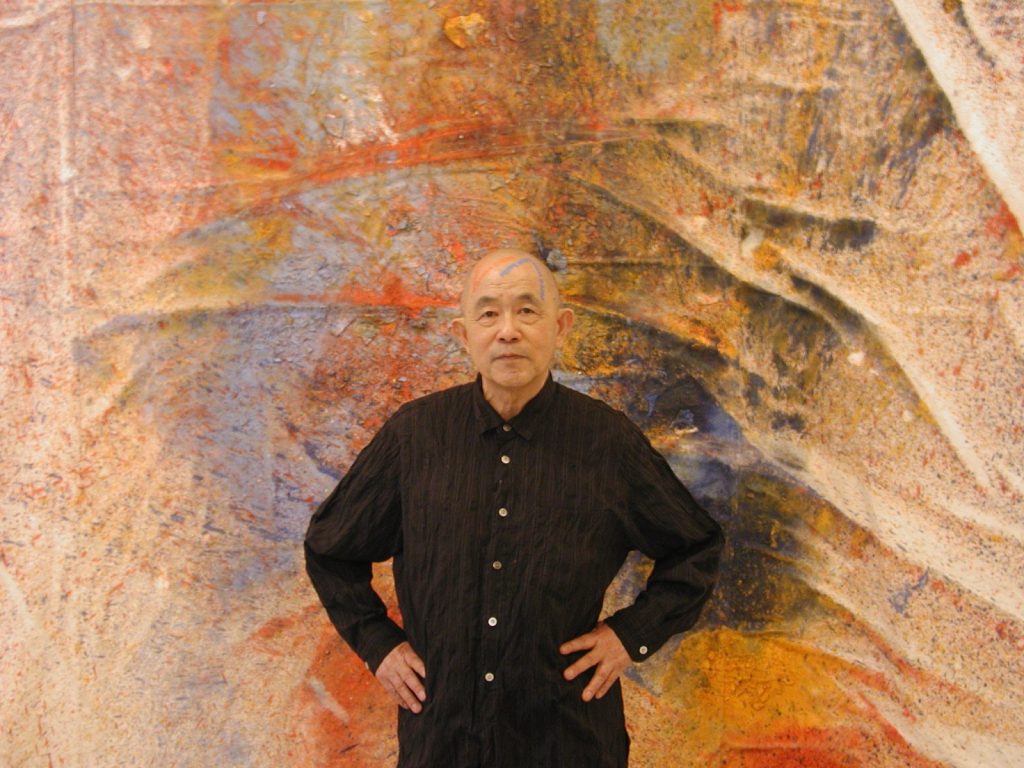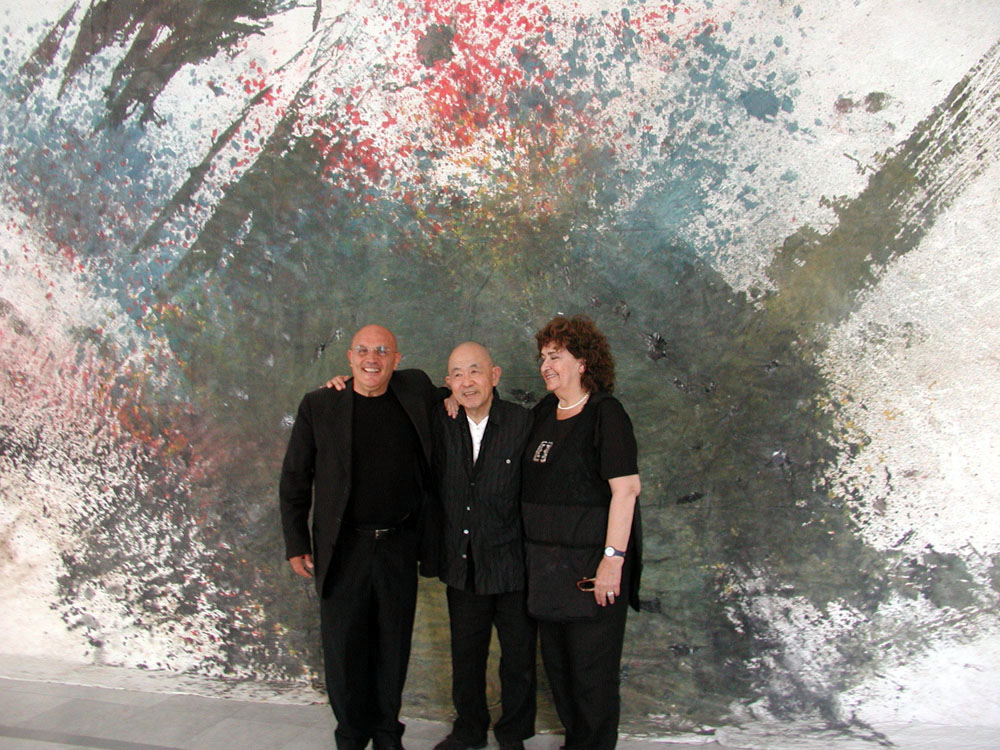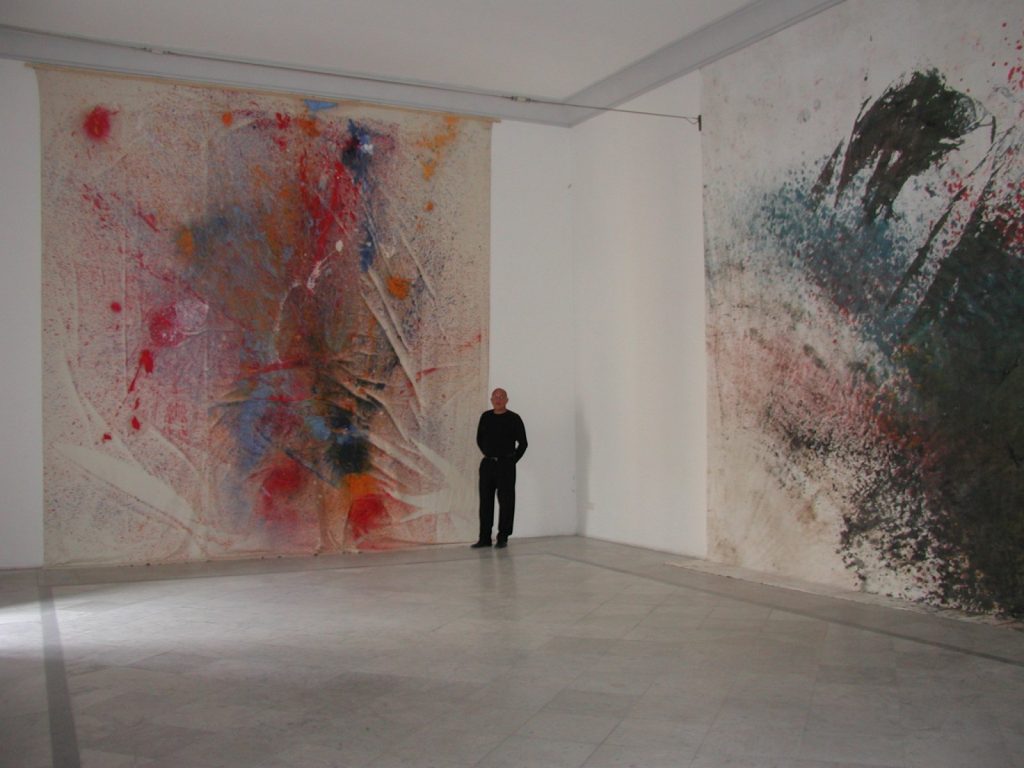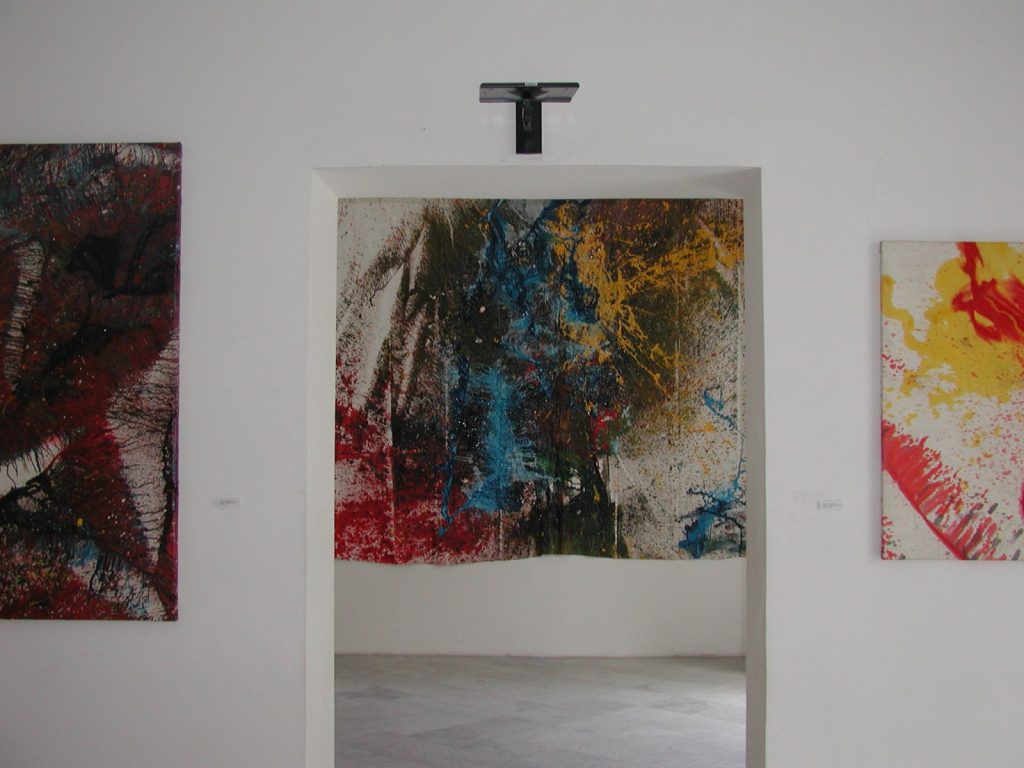Solo Show
2006 Shozo Shimamoto. Opere anni ’50-’90, Palazzo dello Spagnolo, Fondazione Morra, Napoli, Italia
SECTION “HOMAGE TO SHOZO SHIMAMOTO”
Artworks of the first Gutai’s period
Room A
Whirlpool (Vortice), Japan, 1967
(Right, wall of entry)
Artwork realized by using of a funnel, long whose walls some liquid colour has been made to strain.
Imbuto 05 (Funnel), Nishinomiya, 1965/1985
(Right, wall of entry)
Artwork realized by using of a funnel, long whose walls has been made to strain some oil colour (1965).
In 1985 to the artwork the “A” of the Japanese alphabet has been assistant, symbol that means “beginning of everything”, “principle”.
Gutai 01, 1950
(Left, wall of entry)
Realized in 1950 the artwork results to be one of the most ancient, if not the first of the Gutai period.
Technique: collage of cardboard and aluminium sheets. A similar artwork has been bought from Tade Modern of London.
Gutai 03, Nishinomiya, 1953
(Left, wall of entry)
An imputable artwork to the first Gutai period. It has been realized by using of a particular varnish, employed in the maintenance of the elevators. An analogous artwork has been published in the first number of the Gutai journal, number in which Jiro Yoshihara introduces the Gutai group.
Buco, (Hole), Osaka, 1946
(Left wall)
The artwork has been realized using as base some newspapers (Japanese) glued between them (the material support still visible on the back) covered of colour, in which, in a second moment, the opening of the hole has been realized. In the left vertical border, it is possible to find the signature of the master.
Gutai, 1953
(Left wall)
An imputable artwork to the first Gutai period. Historically among the most important, because published on the first number of the Gutai journal, direct and written by the master founder of the movement Jiro Yoshihara.
It is realized gluing pieces of paper rolled up on which the colour has been spread out.
Lavoro Gutai con buco (Gutai artwork with hole), Japan, 1953
(Right wall)
Gutai artwork exposed to the Gutai demonstration of Ashiya in 1954, and subsequently (after) to the Sander Gallery in Germany.
Lancio di bottiglia 04, Osaka, 1991
(Frontal wall)
Artwork realized through the throwing of bottles containing oil colour. In the execution time some objects have been positioned above and under the cloth, carefully chosen by the master with the purpose to give a direction to the colour. The pictorial surface is characterized by the presence of the glassy residues of the throwing englobed in the colour.
Taiho (Cannone – Cannon), Japan, 1956
(Frontal wall)
The artwork, published in the magazine Gutai n° 5, constitutes an unicum for his characteristic executive material. It is realized through the aid of a cannon, from which the colours inserted in specific plastic containers have been separate on a special cloth.
Crash Bottle (Schianto di Bottiglia), 2000
(Two artworks of the same series, one positioned to the right of the jobs of the entry to the room C, the other in the frontal wall on the left side).
The artworks have been realized through the throwing of bottles, that contain the oil colours, from an helicopter.
A Sesshu, 1997
(Left wall)
The artwork has been realized using as base an original drawing of Sesshu (Buddhist Zen Monk that lived at the end of ‘400 and that in China learned the technique of the monochrome; he was one of the more interesting Japanese artists of the Muromachi age), on which has been represented the letter A of the Japanese alphabet.
The artwork re-enters in the series “A.”, group of jobs in which the master Shimamoto often makes reference to the letter A of the Japanese alphabet, symbol of good wish that means “the beginning of everything ” also means ” some art, the creation, the principle”. To the actual state this is the job more rated of the master, because the use of the appreciated fifteenth-century drawing.
Lancio di Bottiglia (Throwing of bottle), Osaka, 1990
(Wall right the other two artworks ” throwing of bottle 02 ” and ” throwing of bottles 03 “, that complete the series, are exposed in the room D)
Artwork realized through the throwing of bottles containing oil colour. In the execution time some objects have been positioned above and under the cloth, carefully chosen by the master with the purpose to give a direction to the colour. The pictorial surface is characterized by the presence of the glassy residues of the throwing englobed in the colour.
This is one of the last artworks realized with this technique.
Tela grande (Big Cloth)
(Left wall)
Artwork realized through the throwing of bottles containing oil colour. In the execution time some objects have been positioned above and under the cloth, carefully chosen by the master with the purpose to give a direction to the colour. The pictorial surface is characterized by the presence of the glassy residues of the throwing englobed in the colour.
2 Opere (2 Artworks), 1979/1985
(Frontal wall)
The artwork has been realized by the master in different times in 1979 and in 1985, using the same type of colour (to oil) but with different techniques.
Artworks room D
Lancio di Bottiglia 03 (Throwing of bottle), Osaka, 1990
(Right, entry wall)
Artwork realized through the throwing of bottles containing oil colour. In the execution time some objects have been positioned above and under the cloth, carefully chosen by the master with the purpose to give a direction to the colour. The pictorial surface is characterized by the presence of the glassy residues of the throwing englobed in the colour.
Lancio di Bottiglia 02 (Throwing of bottle), Osaka, 1990
(Left, entry wall)
Artwork realized through the throwing of bottles containing oil colour. In the execution time some objects have been positioned above and under the cloth, carefully chosen by the master with the purpose to give a direction to the colour. The pictorial surface is characterized by the presence of the glassy residues of the throwing englobed in the colour.
Tela grande, 2000 (Big Cloth)
(Left wall)
Artwork realized through the throwing of bottles containing oil colour. The pictorial surface is characterized by the presence of the glassy residues of the throwing englobed in the colour.
Tela grande (Big Cloth)
(Right wall)
Artwork realized through the throwing of the colour.
Lancio su Cashmere (Throwing on Cashmere), Performance Londra, “Japan year in London”, 2001
(Big cloth, frontal wall)
Artwork realized through the throwing of bottles containing oil colour on a Cashmere cloth. The pictorial surface is characterized by the presence of the glassy residues of the throwing englobed in the colour. A artwork realized in 2001 in the Performance of London ”Japan year in London”.
A pillow to dream, (Un cuscino per sognare 02), Koshieguchi, 2005
The pillow has been realized using the cashmer painted in 2001 in the Performance of London ”Japan year in London”
The pillow takes back in its form the letter A (lengthened) of the Japanese alphabet. The artwork re-enters in the series “A”, group of jobs in which the master Shimamoto often makes reference to the letter A of the Japanese alphabet, symbol of good wish that means “the beginning of everything ” also means ” some art, the creation, the principle”. The pillow has been sewn from Nishizwa Miyuki “ the Newspaper Woman”.
Artworks room B
(Right size, “Homage to Shimamoto”, artworks 2000/2005)
10 metri (10 m), Itami, 2000
Artwork realized through the throwing (from a height of thirty meters) of colours to water-colour from a crane to which the master had been insured. The colours were inserted in special plastic glasses with cork and assembled in a sphere built from Loco, a disciple of master. The artwork is long around ten meters, from which the name. The artistic performance realized in Venice has been taken care of and organized by another important master of Gutai Yasuo Sumi.
Ice Artwork (Opera di ghiaccio) 03, September 2004
(Right, wall of entry)
The artwork constitutes an unicum for his characteristic executive material.
The job has been realized preparing on the cloth of the plates of frozen water-colours.
Ice Artwork (Opera di ghiaccio) 06, September 2004
(Left, wall of entry)
The artwork constitutes an unicum for his characteristic executive material.
The job has been realized preparing on the cloth of the plates of frozen water-colours.
Ape, Itami, 2000
Artwork realized through the throwing (from a height of thirty meters) of colours to water-colour from a crane to which the master had been insured. The colours were inserted in special plastic glasses with cork and assembled in a sphere built from Loco, a disciple of master. The artwork is long around ten meters. The artistic performance realized in Venice has been taken care of and organized by another important master of Gutai Yasuo Sumi.
Lancio di Loco (Throwing of Loco), Itami, 2000
Artwork realized through the throwing (from a height of thirty meters) of water-colour from a crane to which the master had been insured. The colours were inserted in special plastic glasses with cork and assembled in a sphere built from Loco, a disciple of master. The artwork is long around ten meters. The artistic performance realized in Venice has been taken care of and organized by another important master of Gutai Yasuo Sumi.
Lancio di Loco (Throwing of Loco), Itami, 2000
Artwork realized through the throwing (from a height of thirty meters) of water-colour from a crane to which the master had been insured. The colours were inserted in special plastic glasses with cork and assembled in a sphere built from Loco, a disciple of master. The artwork is long around ten meters. The artistic performance realized in Venice has been taken care of and organized by another important master of Gutai Yasuo Sumi.
Helicopter Performance Work 03
Helicopter Performance Work 06
Helicopter Performance Work 07, Trevi (Italy), 2005
Artworks realized through the throwing, from an helicopter, of water-colours mixed to Japanese ink, and contained in special plastic glasses. The work has been performed by the master Shimamoto during a particular performance realized in the sporting field of Trevi (Italy), May 26, 2005.
Paraventi (Screens), Japan, around 1990
The two works belong to the series of the screens,realized through the use of Japanese models on whose body has been spread out Japanese ink.
SECTION “HOMAGE TO YASUO SUMI”
Artworks room B
(Left size, frontal wall)
Pergamene (Parchments series, parchments on cloth n°4),Itami, 1981
(Frontal wall)
Artworks realized on cloth through the aid of an abacus and a vibrator to stretch the Japanese ink and the colour.
“Hanging scroll 2”, Parchments series, parchments on paper and cloth, Japan, 1981.
(Left work, wall of entry)
Artworks realized on paper and cloth through the aid of an abacus and a vibrator to stretch the Japanese ink and the colour.
Central artwork, Itami, 1997
(Left size, frontal wall)
Artwork realized on paper through the aid of an abacus and a vibrator to stretch the Japanese ink and the colour.
Itami, 2005
(Right,wall of entry)
Artwork realized on cloth through the aid of an abacus and a vibrator to stretch the Japanese ink and the colour.
Itami, Reggio Emilia, Italy, 2005
(Left size, frontal wall, big cloth)
Artwork realized through the aid of an abacus, a vibrator and a Japanese umbrella (bangasa) to stretch the ink and the colour on the cloth.
Realized by master Sumi during a performance in reggio Emilia (Italy) in month of May 2005.
Itami,2004
(Left size, frontal wall)
Artwork realized on cloth through the aid of an abacus to stretch the colour.
SECTION “HOMAGE YOZO UKITA ”
Artworks room Zero
(artwork from left)
One Point and One Thread, Japan, 2005
Oli painting with a gunny sack collage.
Wings, Japan, 2006
Oli painting with a gunny sack collage.
One Point 02, Japan, 2006
Oli painting with a gunny sack collage.
One Point 01, Japan, 2006
Oli painting with a gunny sack collage.
New Concept, Japan, 2006
Oli painting with a gunny sack collage.
A Loop, Japan, 2006
Oli painting with a gunny sack collage.




